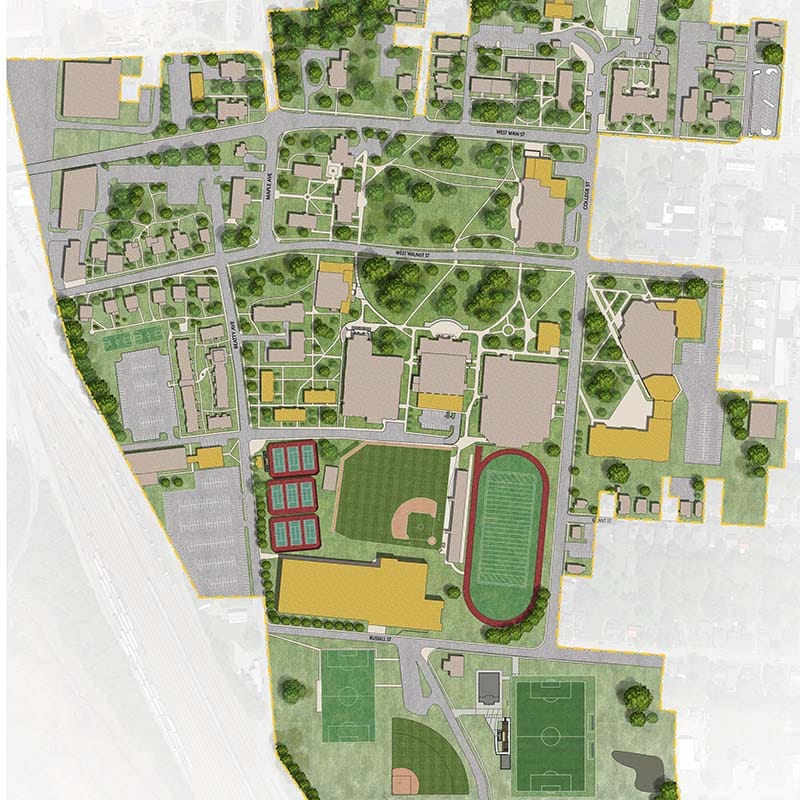The Landscape of Post-Pandemic Master Planning, Part II

Wednesday, October 13, 2021
With most colleges and universities returning to some semblance of pre-pandemic activities this fall, there is much to consider regarding which pandemic-inspired changes will become commonplace in higher education and which adaptations will become a distant memory. Since our experts have learned more from our clients about how higher education has adapted to the longer-term conditions of the COVID-19 pandemic, we are excited to deliver our second look at the future of post-pandemic master planning. You can access “The Landscape of Post-Pandemic Master Planning, Part I,” which was published in March 2021 to share initial themes our team observed. While our experts expect that much of higher education will revert to many pre-COVID-19 tendencies, there are a number of trends that will influence future master planning efforts. Our experts developed the following list of considerations as colleges and universities transition beyond COVID-19 adaptation and higher education looks to the post-pandemic future:
- The dedensification of student housing became a necessity to create safer living environments for students. Many colleges and universities reduced housing capacity with the aim of slowing the spread of COVID-19 and reducing quarantining on campus. Others allowed more students to live off campus during the height of the pandemic to reduce strain on existing campus housing resources. However, dedensification of student housing was a trend observed before the pandemic as students desired a more private, comfortable living experience on campus. While it may not be realistic for most colleges and universities to take a measure as drastic as eliminating all shared student rooms going forward, there is opportunity to make existing on-campus student housing more comfortable and safe for students. Renovating existing student housing units to be more comfortable and private for students and building new state-of-the-art housing will allow on-campus housing accommodations to remain competitive with off-campus options. This could prove to be an effective strategy to encourage students to live on campus again, if desired. Post-pandemic master plans should direct resources to updating existing student housing with more private student bathrooms and living quarters and dedicated community-building and study zones to accommodate the demands of online and hybrid learning. A post-pandemic master plan might even consider the need for more or less student housing and critically examine whether current housing types suit student preferences and expectations.
- Flexible student dining options that became more commonplace during the pandemic may be indicative of the way campus dining programs must adapt to meet student expectations. For example, many campuses offered more grab-and-go options, food delivery, and similar flexible systems that created a safer dining experience. The growing popularity of mobile food ordering and delivery services has drastically shaped student expectations for the level of customization available in an on-campus dining experience. While our experts believe that on-campus dining will remain an important part of the traditional campus experience, the greater variety students see with food ordering and delivery services will be factors campus dining programs must address. Particularly for college and university campuses with fast food and causal dining options just off campus, dining programs and their setup must evolve with student expectations to remain competitive. Dining programs with limited hours, limited menu choices, and limited access will become less desirable, while programs that champion many choices and wide accessibility will be sought after by students. When creating a campus master plan, colleges and universities must consider how food service, catering, and prep space needs may evolve as dining programs adapt to meet the expectations of students.
- Outdoor classrooms, plazas, and gathering spaces will remain relevant places for class meetings, campus events, and general student use. To create safer learning environments, some colleges and universities created makeshift outdoor classroom spaces. While most institutions have transitioned back to using traditional classroom buildings, there still remains significant benefits to having outdoor spaces specifically designed to facilitate class meetings and serve as community gathering spots. Outdoor learning has been found to increase attentiveness, elevate moods, and motivate individuals to work more collaboratively and creatively. Outdoor classroom spaces help transform more traditional pedagogies and may boost student learning in the process, fostering a more holistic learning environment. Additionally, many campuses have significant opportunity to enhance or build patios, plazas, and amphitheaters to accommodate outdoor student events. Activating existing outdoor spaces creates a more energized campus and helps build a sense of community. Post-pandemic master plans should consider existing outdoor gathering spaces and circulation patterns and determine whether they promote or prohibit interaction within the community. Equipping outdoor spaces with technology, furniture, and lighting creates additional usable space on a campus.
The previous points present just a few themes our experts are considering in greater detail given the changes and adaptations made to cope with the conditions of the pandemic. To learn more about master planning experience, click here. To talk further about how the post-pandemic landscape is impacting campus master planning contact Erik Kocher at [email protected] or (314) 529-4004.